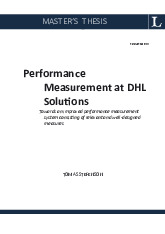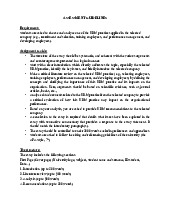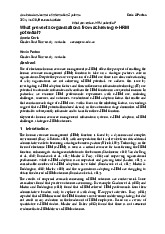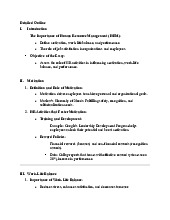









Preview text:
VIETNAM NATIONAL UNIVERSITY - HO CHI MINH CITY
INTERNATIONAL UNIVERSITY SCHOOL OF BUSINESS MIDTERM ASSIGNMENT
AGING WORKFORCE IN KOREA
Student’s Name: Dinh Thi Quynh Hoa Student’s ID: BABAIU20054 Lecturer: PhD. Pham Tan Nhat Subject: Human Resources Management Date: 11/10/2023 I. Introduction
Aging populations are a challenge facing many developed countries and emerging
markets. The growing elderly population represents not only an increase in the
proportion of older people remaining in the labor force but also a change in the age
distribution of the labor force. It poses difficult questions for that country's economic
development and social security benefits.
One of the nations having a rapidly aging population is Korea. The employment-
topopulation ratio of people 65 and over in 2022 was 36.2%, up 6.1% from a decade
earlier. The greatest employment-to-population ratio of the elderly was observed in
South Korea in 2021 among OECD members. Over two decades, the proportion of
older adults (50–64) in the working-age population (15–64) has increased significantly
from 59.3% in 2000 to 70.6% (in the same age group ) by 2020 (OECD, 2022). Due
to low birth rates and high life expectancy, the elderly workforce is anticipated to
expand even more quickly. This situation is becoming more serious as the number of
married couples is decreasing, leading to a decrease in the birth rate, increasing the
risk of Korea facing a population disaster. For many years in a row, Korea has been in
the group of developed countries with a decreasing birth rate and currently the birth
rate in Korea is the lowest in the world. After the first generation of birth statistics in
1970, the total fertility rate (the number of births a woman would have if she
experienced the present age-specific birth rates throughout her childbearing years)
reported 0.78 children per woman in 2022, setting a new record low. In this report, I
will present some of the challenges that an aging workforce presents based on
published data and then recommendations for this phenomenon. II. DATA ANALYSIS
1. Decrease of Workforce
Changes in the labor force's size and age composition, as well as slow and eventually
negative labor force growth, will be the main effects of rapid aging on the labor force.
In 2022, the working age population (15–64) made up 36.69 million people, or 71.0%
of the total population. 17.5% (9.15 million people) of the population were seniors
(age 65 or over). The number of people under the age of 15 and those in the working
age group decreased by 228 thousand (-0.4%) and 258 thousand (-0.6%), respectively,
compared to 2021. While the elderly population increased by more than 440 thousand
people (0.9%). The proportion of people who are working age decreased by 2.2%p (-
883 thousand people) compared to 2017.
Table 1. Population projections in Korea
The percentage of South Korea's working-age population, which peaked at 73.4% in
2012, is expected to decline from 54.4% in 1970 to 71.0% in 2022, 56.8% in 2040,
and 46.1% in 2070. According to projections, South Korea's percentage of the elderly
population will increase from 3.1% in 1970 to 17.5% in 2022, a six-fold increase. In
2070, this percentage is predicted to increase to 46.4%.
Figure 1. Population Prospects (based on the 2021 Population Projections)
Besides, Korea's birth rate reaching a record low has brought a threat to the futur
workforce. After the first generation of birth data in 1970, the total fertility rate (the
Figure 2. Number of live births and total fertility rate (1970-2022)
number of births a woman would have if she experienced the present age-specific birth
rates throughout her reproductive years) reported 0.78 children per woman in 2022,
setting a new record low. The crude birth rate, which is the number of live births per
1,000 people, was 4.9 in 2022, down from 5.2 in 2021.
Population aging in Korea will lead to a significant decline in future economic growth
due to falling savings rates and negative labor productivity growth by being harnessed
by an ageing population. In addition, labor productivity growth in Korea in 2022 is
0.1%, much lower than the average of 2.0–4.0% over the past 12 years. The
GDP per capita growth potential of Korea is predicted by the OECD Long-Term Model
to decrease from around 3% per year in 2005–22 to approximately 1% per year in
2023–2060. A decrease in the working-age population is responsible for almost half of the fall.
Figure 4. Potential GDP growth based on prediction of OECD
2. High dependancy ratio
Above all, an aging population will lead to a continuous increase in the dependency of
the elderly.According to projections, the old-age dependence ratio would climb from
22.5 individuals per 100 people of working age in 2020 to 63.4 persons per 100 people
in 2040 due to an increase in the older population. Increasing numbers of elderly
people and their reliance on assistance will put a significant burden on public coffers,
among other factors. The increasing proportion of elderly and elderly dependents will
create serious strain on public finances.
Figure 5. Denpendency ratio
South Korea's pension spending over the years has increased significantly from 1.97%
of GDP in 2010 to 3.61% of GDP in 2022, according to the OECD, and there is no
decreasing trend. In addition, according to a report by Korea Statistic, the total number
of workers registered to receive pensions increased by 2.8% from 6.648 million people
in 2020 to 6.838 million people in 2021, this causes huge damage to the government's
budget. There may be a variety of intergenerational conflicts and slower economic
development as a result of the anticipated increase in public spending as well as the
corresponding increases in taxes and social security contributions.
The rapidly aging population and health-related budget pressures to improve the
quality of life for the elderly while reducing the care burden of families, as well as is
weighing on government spending. As a result of Germany and Japan adopting similar
policies, South Korea became the third OECD country to implement LTCI, or long-
term social insurance care The LTCI benefit consists of three components: financial
compensation in some circumstances, institutional care, and home care. From 2009 to
2018, the average annual rise in public LTCI spending per beneficiary was 5.4%,
resulting in 12,705 USD (0.37 percent of GDP) in 2018.
Figure 6. Pension spending by public, %GDP, 2010 -2020
Table 2. Expenditure under public LTCI
3. Reduce national financial sustainability
The aging population poses a significant threat to financial sustainability because
of growing costs and declining income. Declining consumption results from a
declining labor force, which lowers tax income. Additionally, social spending has
been steadily rising on programs connected to the elderly, such as health care,
public pensions, and other safety nets. Most nations might face severe long-term
financial hardship as a result of this, particularly developing nations with less
established and mature social protection programs. Meanwhile, improved social
integration and sustainable growth are necessary for an expanded social security system.
Older workers are also challenged by the skills needed in South Korea's increasingly
knowledge-based economy. The proportion of the 55–64 age group with a university
degree was only 13% in 2010, compared with 65% of the 25–34 age group, the third
highest among OECD countries. The gap in educational attainment between age groups
is the widest among OECD countries, putting older workers at a competitive disadvantage.
Additionally, 65% of workers age 50 and older are in physically demanding jobs such as
manual labor that tend to be low paid (Jones & Tsutsumi, 2009). This also leads to a
serious impact on the income of the elderly and promotes early retirement. III. RECOMMENDATIONS
1. Improving hiring and job retention for older workers in Korea
Government laws should be implemented to allow workers to retire for longer
periods of time. For example, the obligatory retirement age could be lowered to
65 years old. Policies that support obligatory retirement and wage setting, such
as those that prohibit age discrimination, should also be in place. The government
need to support laws that forbid age discrimination in the workplace, support
senior employment, and forbid treating older employees unfairly when it comes
to recruiting, firing, and compensation. employment, education, career
progression, and other facets of the working world. It is possible to reduce age
discrimination in Korea by altering the cultural norms of the labor market. It will
also call for a shift in HRM methods from the existing tenure- and age-based ones
to ones that are more performance- and job-based.
2. Improving skills and productivity
Whether or not older workers find it harder to pick up new skills is a crucial factor
in determining how aging impacts production era where the workforce is aging
quickly, the main concern is how to maintain older workers' productivity and
employability. Over the coming decades, an increase in the share of older workers
may hinder human capital growth and technological progress in Korea if old
workers are less productive than young workers. However, if they are better
educated, continue to grow their human capital after formal schooling by
adapting to new technology, and have more job experience, their productivity
may not be lower than younger people.
3. Improve working conditions
Good working conditions can play a significant role in an era of rapidly aging
societies as a means to keep the productivity of older workers through declining
working hours and the establishment of occupational health and safety
systems.For elderly individuals, extended work hours might have particularly
negative effects on their health and skill development. In order to protect senior
workers' physical and mental health and prevent workplace mishaps, all Korean
workers must work less hours. It is imperative that employers take a firm stand
in providing work environments that support the health of their employees,
particularly the elderly, and guard against occupational illnesses, accidents, and
stress. work. It is important to consider the emotional and physical well-being of
employees while creating a work environment that includes equipment, supplies,
procedures, and scheduling. In collaboration with regional health organizations,
a system may be put in place to periodically check on the health of the workforce,
which would include older individuals. Furthermore, actions should be done to
implement financial sickness benefits and employer-paid sick leave.
4. Provide flexible work
Employers and workers may both benefit from more flexible work arrangements,
which can increase productivity and labor market efficiency. More flexibility in
work schedule scheduling may be a better tactic in a business climate that is
changing quickly than modifying the workforce in terms of the numbers that
organizations can keep. Hire highly trained personnel and save money on recruiting,
firing, and skill development. Certain worker groups may also find their ability to
work improved, particularly those whose capacity to work long hours or take care
of their families is restricted by health issues. Flexible working allows employees
to pick when their workday begins and ends, or it can raise or reduce regular
working hours every three months while maintaining the same regular working hours. IV. CONCLUSION
The facts in South Korea's remarkably aging labor force is examined in this essay.
The article touches on a number of topics, including the burden on the country's
finances, the high reliance rate on the elderly, and the declining working-age
population. This appears to provide significant obstacles for a large number of
Korean enterprises, both domestically and internationally.
The country's most pertinent HR practices aim to improve the career skills of older
workers, as the working-age population is shrinking due to low birth rates. Policies
that support working conditions in tandem with government priorities are crucial
to keeping this age group employed. All things considered, one of the most
common issues facing many established and developing nations is an aging labor force. V. REFERENCES
1. Document viewer. (n.d.).
https://kostat.go.kr/synap/skin/doc.html?
fn=9552061b015f64840f54bccd53e4581b1bf5c38c51a47c64d7893e7d74494f8c&rs=/ synap/preview/board/11748/
2. KOSIS. (n.d.-b). https://kosis.kr/statHtml/statHtml.do?
orgId=101&tblId=DT_1BPA001&vw_cd=MT_ETITLE&list_id=A41_10&scrId=&lang
uage=en&seqNo=&lang_mode=en&obj_var_id=&itm_id=&conn_path=MT_ETITLE&p
ath=%252Feng%252FstatisticsList%252FstatisticsL
3. Document Viewer. (n.d.-b). https://kostat.go.kr/synap/skin/doc.html?
fn=28d4e6ebe658b21382894dee543d19c2bdfe672625e4aa26b9dfcd12879574be&rs=/ synap/preview/board/11773/
4. Document Viewer. (n.d.-c). https://kostat.go.kr/synap/skin/doc.html?
fn=9552061b015f64840f54bccd53e4581b1bf5c38c51a47c64d7893e7d74494f8c&rs=/ synap/preview/board/11748/
5. Document Viewer. (n.d.-e). https://kostat.go.kr/synap/skin/doc.html?
fn=95dc9272d0f2aae058424b321bcb4b15b62ab7f3c5d8b613596ae59504aff6f6&rs=/ synap/preview/board/11748/
6. Productivity - Labour productivity and utilisation - OECD data. (n.d.). theOECD.
https://data.oecd.org/lprdty/labour-productivity-and-utilisation.htm#indicator-chart
7. Social protection - Pension spending - OECD data. (n.d.). theOECD.
https://data.oecd.org/socialexp/pension-spending.htm#indicator-chart
8. Health resources - Health spending - OECD data. (n.d.). theOECD.
https://data.oecd.org/healthres/health-spending.htm
9. OECD (2022), OECD Economic Surveys: Korea 2022, OECD Publishing, Paris,
https://doi.org/10.1787/20bf3d6e-en.
10. Kim, H., & Kwon, S. (2020). A decade of public long-term care insurance in South
Korea: Policy lessons for aging countries. Health Policy, 125(1), 22-26
https://doi.org/10.1016/j.healthpol.2020.11.003
11.Working better with age: Korea. (n.d.). https://doi.org/10.1787/9789264208261-en
12.Phang, H. (2011). Issues and challenges facing population ageing in Korea:
productivity, economic growth, and old-age income security. Journal of
Comparative Social Welfare, 27(1), 51-62.



